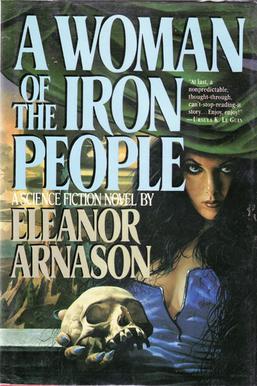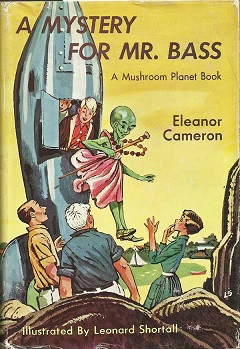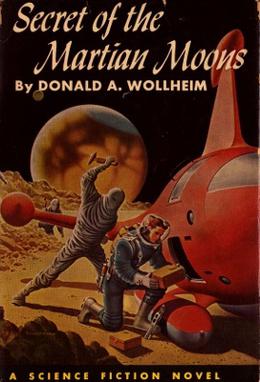
Foundation's Edge (1982) is a science fiction novel by American writer Isaac Asimov, the fourth book in the Foundation Series. It was written more than thirty years after the stories of the original Foundation trilogy, due to years of pressure by fans and editors on Asimov to write another, and, according to Asimov himself, the amount of the payment offered by the publisher. It was his first novel to ever land on The New York Times best-seller list, after 262 books and 44 years of writing.

Little green men is the stereotypical portrayal of extraterrestrials as little humanoid creatures with green skin and sometimes with antennae on their heads. The term is also sometimes used to describe gremlins, mythical creatures known for causing problems in airplanes and mechanical devices.

Eleanor Frances (Butler) Cameron was a children's author and critic. She published 20 books in her lifetime, including The Wonderful Flight to the Mushroom Planet (1954) and its sequels, a collection of critical essays called The Green and Burning Tree (1969), and The Court of the Stone Children (1973), which won the U.S. National Book Award in category Children's Books.

A Woman of the Iron People is an anthropological science fiction novel by American writer Eleanor Arnason, originally published in 1991. It is a first contact story between peoples from a future Earth and an intelligent, furred race of people who live on an unnamed planet far from Earth.

The Unteleported Man is a 1966 science fiction novel by American writer Philip K. Dick, first published as a novella in 1964. It is about a future in which a one-way teleportation technology enables 40 million people to emigrate to a colony named Whale's Mouth on an Earth-like planet, which advertisements show as a lush green utopia. When the owner of a failing spaceship travel firm tries to take the 18-year flight to the colony to bring back any unhappy colonists, powerful forces try to stop him from finding out the truth.

Stowaway to the Mushroom Planetis the second in the series of Mushroom Planet books by Eleanor Cameron, and was published in 1956, two years after The Wonderful Flight to the Mushroom Planet.

Claims of the existence of other moons of Earth—that is, of one or more natural satellites with relatively stable orbits of Earth, other than the Moon—have existed for some time. Several candidates have been proposed, but none have been confirmed. Since the 19th century, scientists have made genuine searches for more moons, but the possibility has also been the subject of a number of dubious non-scientific speculations as well as a number of likely hoaxes.

Mr. Bass's Planetoid is a 1958 children's science fiction novel by Canadian author Eleanor Cameron. The novel follows The Wonderful Flight to the Mushroom Planet (1954) and Stowaway to the Mushroom Planet (1956). The book is illustrated by Louis Darling.

A Mystery for Mr. Bass is a 1960 children's science fiction novel by Canadian author Eleanor Cameron. The novel followed The Wonderful Flight to the Mushroom Planet (1954), Stowaway to the Mushroom Planet (1956), Mr. Bass's Planetoid (1958), and it was illustrated by Leonard Shortall.

Time and Mr. Bass is a 1967 children's science fiction novel by Canadian author Eleanor Cameron. The novel followed The Wonderful Flight to the Mushroom Planet (1954), Stowaway to the Mushroom Planet (1956), Mr. Bass's Planetoid (1958), A Mystery for Mr. Bass (1960), Jewels from the Moon and the Meteor That Couldn't Stay (1964), and was illustrated by Fred H. Meise. It is the concluding installment of her Mushroom Planet series.

Flight to Mars is a 1951 American Cinecolor science fiction film drama, produced by Walter Mirisch for Monogram Pictures, directed by Lesley Selander, that stars Marguerite Chapman, Cameron Mitchell, and Arthur Franz.

Jewels from the Moon and The Meteor That Couldn't Stay is a 1964 children's science fiction book written by Eleanor Cameron and illustrated by Vic Dowd. Although the book features characters from Cameron's five Mushroom Planet books, it is tangential to the series. In fact, it is little known even to fans of the series because it was designed as a school reading book and was distributed in that manner by the American Book Company. The book is 64 pages long and features comprehension, discussion, and vocabulary questions after each story.

The Lost Planet is a 1953 juvenile science fiction novelisation by Angus MacVicar, published by Burke, London. It is the first of the popular novel series The Lost Planet, which had originally been written for radio and was later adapted for television

Galactic Derelict is a science fiction novel by American writer Andre Norton, the second in her Time Traders series. It was first published in 1959, and as of 2012, had been reprinted in eight editions. It is part of Norton's Forerunner universe.

Five Against Venus, written by Philip Latham, is a science-fiction novel first published in the United States in 1952 by the John C. Winston Company. Philip Latham was the nom de plume of Robert S. Richardson, a professional astronomer who also provided technical assistance on movies such as Destination Moon and wrote scripts for the Captain Video television series.

The Secret of the Martian Moons is a science-fiction novel by Donald A. Wollheim. It was first published in 1955 by the John C. Winston Company. Playing world-class hide-and-seek with the Martians, Nelson Parr believes that he has found them... until the real Martians show up. This is the second novel that Wollheim wrote for Winston, the other two being The Secret of Saturn's Rings (1954) and The Secret of the Ninth Planet (1959).

Starship Through Space is a science-fiction novel written by G. Harry Stine under the pseudonym Lee Correy. It was published in 1954 by Henry Holt and Company. The book tells the story of the building of the first starship and of its flight to Alpha Centauri.

The Beyond the Red trilogy is a series of young adult dystopian science fiction novels by Gabe Cole Novoa, writing under the pen name Ava Jae. Set on a planet where humans and a humanoid native species are in violent conflict, the books include action, forbidden romance, political intrigue, and queer themes.

The Last Cuentista is a middle-grade dystopian novel by Donna Barba Higuera, published October 12, 2021 by Levine Querido. The story follows Petra Peña who, along with her family and a few hundred others, leave Earth to continue the human race after a comet strikes the planet. After awaking on a new planet, Petra is the only one who remembers Earth and must use storytelling to keep her people's history alive. It was published in British English under the title The Last Storyteller in 2022.
The year 1954 was marked, in science fiction, by the following events.



















